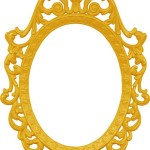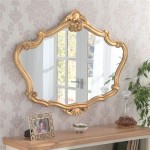Flat Screen TV Behind Mirror: A Discreet Technological Integration
The integration of a flat screen television behind a mirror, often referred to as a “mirror TV,” represents an increasingly popular trend in interior design and home automation. This technology allows for a seamless blend of entertainment and aesthetics, providing a functional television screen that transforms into a standard mirror when not in use. This integration addresses the challenge of incorporating large electronic devices into interior spaces without compromising the overall design scheme.
Mirror TVs are not a monolithic product; rather, they encompass a range of technologies and installation methods. Understanding the nuances of these variations is crucial for homeowners, interior designers, and architects considering this option. Factors such as the type of mirror glass, the underlying TV screen, the installation environment, and the control system all contribute to the final product’s performance and longevity.
The core principle behind a mirror TV lies in the optical properties of specialized mirror glass. This glass possesses a semi-reflective coating that allows light to pass through in one direction and reflect in the other. When the television behind the glass is turned off, the reflective coating dominates, creating a standard mirror appearance. When the television is powered on, the light emitted from the screen overcomes the reflective properties, allowing the image to become visible.
Key Point 1: Understanding the Underlying Technology
The technology behind mirror TVs extends beyond simply placing a standard television behind a mirror. Several critical components contribute to the successful operation of this integration. The specific type of mirror glass is paramount. Standard mirrors are not suitable, as they are too opaque and would severely impede the visibility of the television screen. Instead, specialized dielectric mirrors are used. These mirrors are engineered with thin layers of materials that reflect specific wavelengths of light while allowing others to pass through. The balance between reflectivity and transparency is carefully calibrated to achieve optimal performance.
The quality of the television screen itself is equally important. Modern LED and OLED televisions are typically used due to their brightness, contrast ratio, and viewing angles. A brighter screen is generally preferred, as it needs to overcome the light reflected by the mirror surface. The resolution of the screen also impacts the viewing experience. While 4K resolution is increasingly common, the optimal resolution depends on the size of the screen and the viewing distance.
Furthermore, the placement of the television within the enclosure behind the mirror is crucial. Proper ventilation is essential to prevent overheating, which can significantly reduce the lifespan of the television. Many mirror TV installations incorporate fans or other cooling systems to dissipate heat effectively. The enclosure itself must be designed to accommodate the television securely while also providing access for maintenance and repairs. Careful consideration must be given to the wiring and cable management to ensure a clean and organized installation.
The reflective properties of the mirror are affected by ambient lighting. In brightly lit rooms, a higher reflectivity mirror might be necessary to maintain a clear mirror image when the television is off. Conversely, in dimly lit rooms, a lower reflectivity mirror might be preferable to maximize the visibility of the television screen when it is turned on. Adjustments to the television's brightness and contrast settings can also help optimize the viewing experience under varying lighting conditions.
Finally, the viewing angle of the television screen should be considered. Some mirror glass can distort the image if viewed from an extreme angle. Selecting a television with a wide viewing angle and positioning it correctly within the enclosure can minimize this distortion. The overall goal is to create a seamless and enjoyable viewing experience that is indistinguishable from viewing a standard television.
Key Point 2: Installation Considerations and Practical Applications
The installation of a mirror TV involves several practical considerations. The location of the TV needs careful planning, taking into account factors such as available space, access to power and cable connections, and the viewing angle. These considerations are not exclusive, and can affect other parts of the installation. A wall-mounted installation might require reinforcing the wall structure to support the weight of the mirror and television. A recessed installation, where the television is set into the wall, requires careful planning to ensure adequate ventilation and access for maintenance.
The electrical connections must be properly routed and concealed. It is crucial to comply with local electrical codes and regulations. A qualified electrician should be consulted to ensure a safe and reliable installation. The control system for the television, such as a remote control or a home automation system, should be easily accessible and user-friendly.
One practical application of mirror TVs is in bathrooms. The mirror serves a dual purpose, providing both a reflective surface and an entertainment screen. However, bathrooms also present unique challenges due to the presence of moisture. The television and its enclosure must be adequately protected from water damage. This may involve using waterproof or water-resistant materials and sealing all connections to prevent moisture from entering the enclosure.
Another popular application is in bedrooms. A mirror TV can be mounted on the wall or integrated into a piece of furniture, such as a dresser or a headboard. When the television is not in use, the mirror blends seamlessly with the room's decor. This allows for a clutter-free and aesthetically pleasing environment. In living rooms, mirror TVs can be used to conceal the television when it is not in use, creating a more sophisticated and minimalist look. They can also be incorporated into custom cabinetry or wall units.
Commercial applications of mirror TVs are also becoming increasingly common. In hotels, mirror TVs can provide guests with entertainment and information while maintaining a stylish and uncluttered room design. In retail stores, mirror TVs can be used to display advertisements or product information, attracting customers' attention and enhancing the shopping experience. In gyms and fitness centers, mirror TVs can provide entertainment and motivation for exercisers.
Key Point 3: Advantages and Disadvantages of Mirror TVs
Mirror TVs offer several advantages over traditional televisions. The primary advantage is their ability to conceal the television when it is not in use, providing a cleaner and more aesthetically pleasing look. This is particularly beneficial in smaller spaces where a large television screen can dominate the room. They offer a unique blend of functionality and design, allowing for seamless integration into various interior styles.
However, mirror TVs also have some disadvantages. The cost of a mirror TV is typically higher than that of a standard television due to the specialized mirror glass and the custom installation requirements. The image quality may be slightly compromised compared to a standard television, as the mirror glass can reduce the brightness and contrast of the screen. The viewing angle may also be limited, depending on the type of mirror glass used.
Maintenance and repairs can also be more complex and costly. Accessing the television behind the mirror may require removing the mirror or disassembling the enclosure. This can be particularly challenging if the television is recessed into the wall. It's important to choose a reputable installer and manufacturer that offers warranty and support services.
Furthermore, the design and installation of a mirror TV require careful planning and coordination. The dimensions of the mirror and the television must be precisely matched to ensure a seamless and aesthetically pleasing appearance. The electrical and cable connections must be properly routed and concealed. The ventilation system must be properly designed and installed to prevent overheating. These factors require careful attention to detail and expertise.
Despite these disadvantages, the advantages of mirror TVs often outweigh the drawbacks for homeowners and designers who are seeking a unique and innovative way to integrate technology into their living spaces. The ability to conceal the television when it is not in use, combined with the sophisticated and minimalist design, makes mirror TVs an attractive option for many applications. The technology continues to evolve, with advancements in mirror glass and television screen technology constantly improving the image quality and viewing experience. Innovations in smart home integration also allow for more seamless control and customization of mirror TV systems.

Vanity Mirror Tv Vanishing Television For Your Bathroom

Tv Behind A Mirror Living Room In Bedroom

Bathroom Tv Mirror Faq

Tv Behind Two Way Mirror High Def Forum Your Definition Community Resource Wall Mounted

Two Way Mirror Flat Screen Tv Framing 5280 Custom

Lcd Tv Behind A Two Way Mirror

Behind The Mirror Lets Get Interesting Tv Shows Up Through For More Information Contact Glass O Framed Living Room Wall Decor

Eclipse Tv Cover By Electric Mirror Tvc 55 Emr615298

Japanese Architecture Featuring Mirror Television

The Living Room Tv As We Know It Is Over Laurel Home








